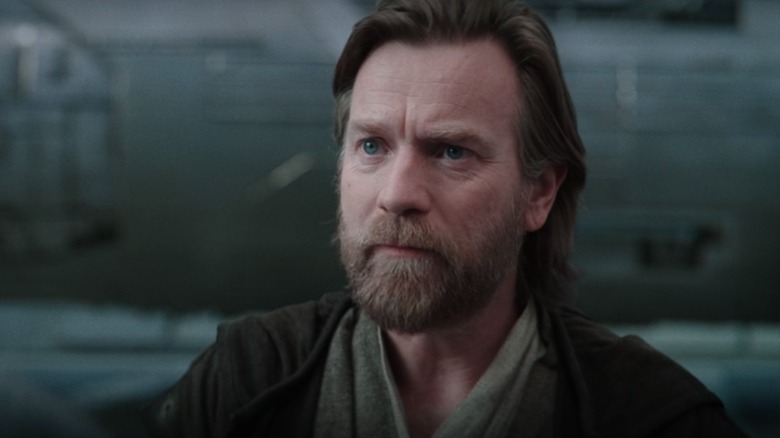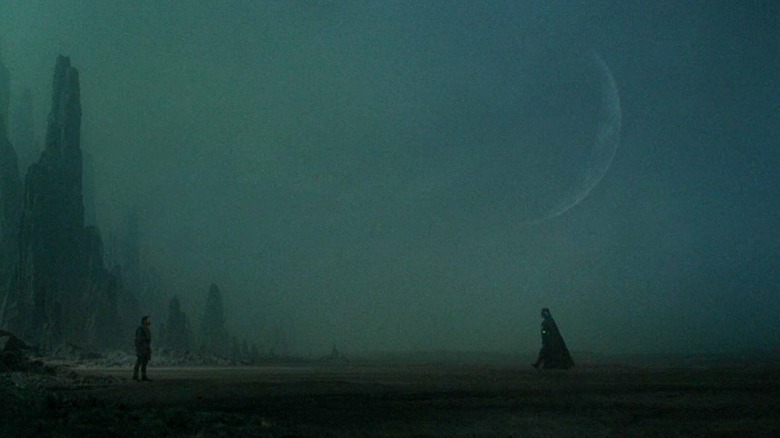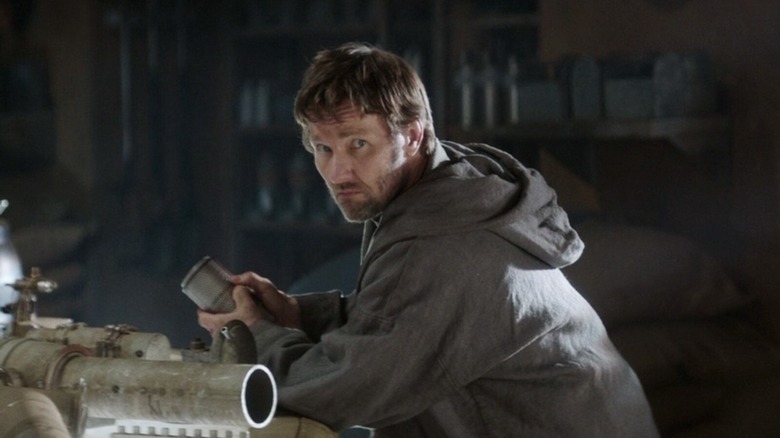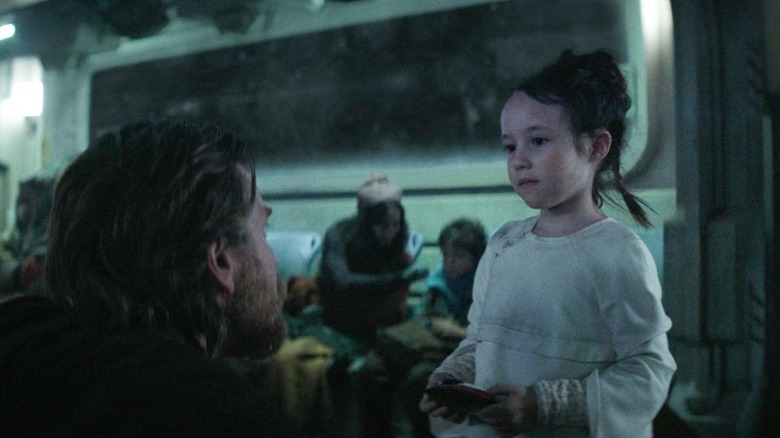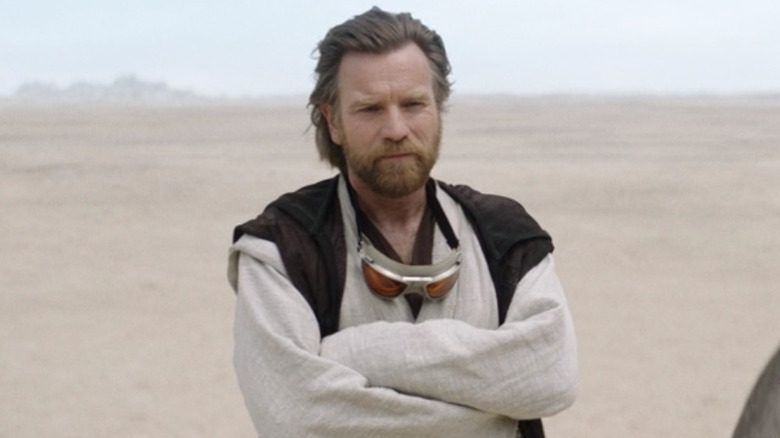Obi-Wan Kenobi Season 1 Ending Explained: Goodbye, Old Friend
Fans have been waiting quite some time for Ewan McGregor to make his return to the "Star Wars" galaxy, and now, after several weeks and six episodes, "Obi-Wan Kenobi" has wrapped up its run on Disney+. Whether or not this is going to be a season finale or a series finale remains somewhat undetermined. But given what limited time we have to work with when it comes to Obi-Wan and his journey before "A New Hope," it seems tough to imagine anything more compelling happening between the finale's conclusion and the beginning of "Star Wars" as we all first came to know it. In any case, the final episode left much to be discussed, particularly in regards to the ending and where all of our characters ended up. So, let's dig in, shall we?
Warning: massive spoilers ahead for "Obi-Wan Kenobi." Proceed with caution.
A brief recap
Truly, there is so much to talk about when it comes to the "Obi-Wan Kenobi" finale, but a brief recap is in order. The episode picks up with the refugees feeling the Empire, this time being chased in a Star Destroyer in a sequence that sort of mirrors the iconic opening of "A New Hope." Because of a bad motivator (I understood that reference!) Roken (O'Shea Jackson Jr.) will likely not have time to get everyone to safety before Vader and the Empire catch up to them. As such, Obi-Wan takes it upon himself to take a smaller ship to lead Vader away despite everyone's protest, with Leia protesting the hardest.
This ultimately leads to the confrontation that we've been waiting for, with Vader and Obi-Wan duking it out for the second-to-last time. Unlike the last time, Obi-Wan has re-aligned himself with the Force and that means he is actually a match for his former apprentice. Rocks are thrown at one another, tempers flare and emotions run high. Ultimately, Obi-Wan comes out on top but can't bring himself to kill his old friend, despite the fact that he finally recognizes that there is nothing of Anakin left under that mask.
But Obi-Wan has one final mission to carry out: save Luke! Indeed, Reva survived and goes to Tatooine to try and kill the boy. Uncle Owen and Aunt Beru do their best to protect him but to no avail. However, Reva, a survivor of Order 66 who saw young Jedi slaughtered, can't bring herself to do the deed. Obi-Wan arrives to comfort her, declaring that she did not become as bad as Vader. She didn't choose hatred.
Obi-Wan gets to reunite with Leia one last time before heading off to actually meet Luke and make peace with Owen before riding off into the twin sunset. In one final little bit of called for fan service, Obi-Wan finally gets to see the Force ghost of his former master, Qui-Gon Jinn, punctuating his journey and cementing the fact that the Jedi we first met in "A New Hope" has finally arrived.
Coloring in the margins
Now we can really get into it. When this show was announced (even though it was originally going to be a movie), it was always going to have a finite area to work within. We know where these characters end up so this is an in-between-quel where you only have so much latitude to move around. Director Deborah Chow did her damndest to provide a satisfying conclusion while coloring in those margins. Why is it that Vader didn't continue to look for Obi-Wan after the events of this show?
Well, Obi-Wan whipped Vader's ass pretty bad on that rock-filled planet and that left an impression. Vader conferred with Palpatine towards the end of the episode via hologram from Mustafar and, when the Emperor implied that Vader's feelings for his former master were clouding his judgment, he made a point to demonstrate that wasn't the case. He is able to focus on the bigger picture and the petulance of Anakin came through from underneath that mask. Proving he doesn't care about Obi-Wan is why he is going to stop overturning stones. For now.
We also get a nice little final bit between young Leia and Obi-Wan on Alderaan that sort of helps to explain why Leia reached out to him in "A New Hope." Kenobi says to her that she can call him if she ever needs help, while also making it very clear that the nature of their relationship cannot be made known for everyone's safety. This helps to set the stage for what happens ten years later when Kenobi is called to rescue the princess once again. Chow is safely coloring within the lines here.
The same can be said for when Obi-Wan finally meets Luke, albeit briefly, and gifts him the T-16 model that we see him with in "A New Hope." It's a little relic left behind by some man he just knows as Ben Kenobi. Again, for now. It's all within the bounds of canon while attempting to add a little something to what we already know.
Compassion over hatred
The "Obi-Wan Kenobi" finale brings things full circle. We start out from a place of utter and complete darkness, with the Empire ruling the galaxy. Our hero is still dealing with the fallout of Order 66 and losing not only his apprentice — but his friend — to the Dark Side. Leia is kidnapped and the Inquisitors are wiping out what very little of the Jedi that remain. There is so little hope to hang a hat on at the start. Yet, by the end of it all,, when Obi-Wan steps off that ship to greet Leia, we can see the Jedi we all know and love is back. There is hope in his eyes once again and he more closely resembles the character originally portrayed by Alec Guinness. A hopeful, compassionate man who is one with the Force.
Obi-Wan even chooses compassion when dealing with Vader, who he had beaten and could have killed. However, When Anakin is revealed under that mask and explains that he killed what was left of his former apprentice, Obi-Wan was able to let go of the guilt he felt. He chose not to kill Vader, perhaps due to the lingering bit of hope left in his heart for redemption. Even when dealing with Reva, who was going to kill Luke, he chooses to show her kindness and light her way forward. On the flip side, Reva, a woman possessed by darkness, chooses light in dealing with Luke, now having a new path to walk divorced from the Dark Side, free of the vengeance in her heart.
Maybe the biggest surprise is the turn by Owen at the end of the show, easing up his cold shoulder in dealing with Kenobi. While he still has a crust to him, which is ultimately all about compassion and care for Luke, he is willing to show Kenobi a kindness that was not there in this show's first episode. Everyone wins by choosing hope and compassion over hatred. If that ain't "Star Wars," I don't know what is.
Hello there
But this show is about one man and "Obi-Wan Kenobi" rightly, at least from a thematic sense, really shifts the focus to him in the end. Even Vader acknowledges that he's back in touch with the Force during their battle. That period of darkness is over for our Jedi and some true growth happens. We really, truly see how the broken man from the end of "Revenge of the Sith" becomes the warm, sort of playful, wise Jedi brought to life by Guinness. There is value in that.
Perhaps nothing illustrates that growth more than Obi-Wan literally decided to leave his dark cave in favor of wandering in the light of the twin suns of Tatooine heading off to live the next ten years of his life before destiny comes calling again in the form of a message from Leia hidden inside of R2-D2. To really put a punctuation mark on the growth here, we finally see Qui-Gon Jinn in all of his Force ghost glory for the first time in Obi-Wan's eyes. This is something that had been teed-up at the end of Episode III but our hero hadn't gotten there yet. As his old master says, "I was always here, Obi-Wan. You just were not ready to see." Now, he's ready for it all.
This moment, with Kenobi riding into the sunset (or rather, sunsets) very much could serve as an end to this part of his journey. Sure, there are another ten years to fill in but the significant parts of the story have been told. It is not my place to say whether or not more story is worth telling but, from a certain point of view, all of the gaps have been filled in so that both Obi-Wan and the audience can move on.
